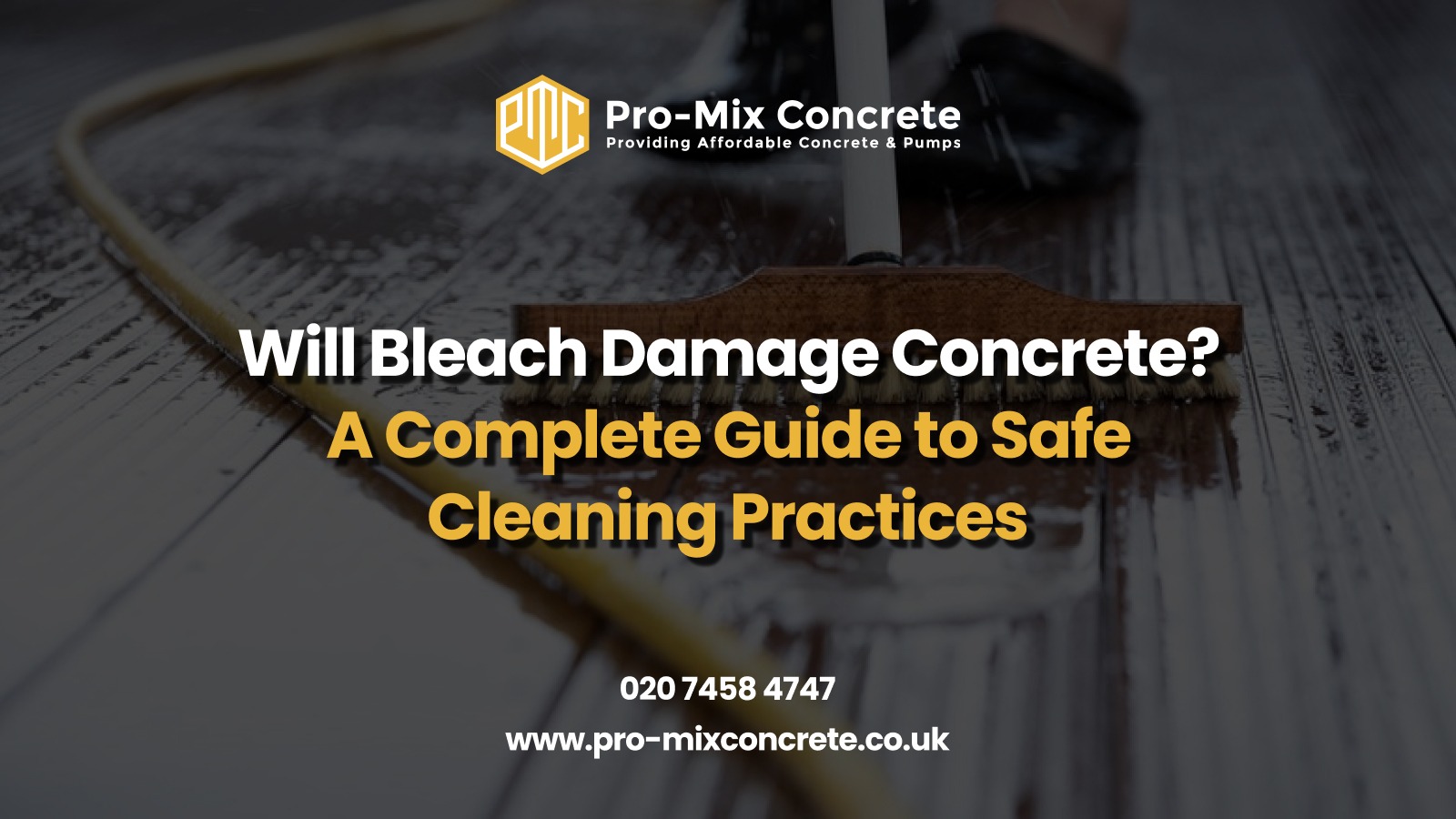Keeping concrete surfaces clean and well-maintained is crucial for their longevity and appearance. Many property owners and maintenance professionals regularly face the decision of whether to use bleach as a cleaning solution for their concrete surfaces. While bleach is a common household cleaner known for its disinfecting properties, its effects on concrete aren’t always straightforward.
The relationship between bleach and concrete is complex and depends on various factors that every property owner should understand. From driveways and patios to industrial floors and foundations, concrete surfaces require specific care to maintain their strength and durability.
Short-term Effects of Bleach on Concrete
When it comes to occasional concrete cleaning, using diluted household bleach typically won’t cause immediate damage to your concrete surfaces. Standard household bleach, containing a 1.5% to 3% solution, can effectively clean concrete without causing significant immediate harm, especially when dealing with surface-level issues like mildew or algae growth.
Proper Application Methods
Dilution is the key factor in safe bleach application – never use straight bleach on concrete surfaces. The standard recommendation is to mix household bleach at a 1:3 or 1:4 ratio with water. During the cleaning process, watch for immediate color changes, unusual surface reactions, or strong chemical odors that persist after rinsing, as these could indicate potential issues.
Professional Maintenance Solutions
Professional maintenance through qualified concrete pump hire services offers significant advantages over DIY cleaning methods. These experts understand appropriate cleaning solutions for different concrete types and have access to professional-grade equipment. Many property managers find that scheduling regular professional maintenance helps maintain their concrete surfaces without risking chemical damage.
Key Professional Benefits:
- Access to industrial-grade cleaning equipment
- Expert knowledge of concrete types
- Professional-grade sealers and treatments
Professional services ensure your concrete surfaces receive appropriate care while minimising the risk of chemical damage.
Long-term and Repeated Exposure Effects
Surface Deterioration Process
While occasional bleach use might seem harmless, repeated exposure can lead to significant concrete deterioration over time. The chemical composition of bleach gradually breaks down the surface components of concrete, particularly when used in higher concentrations. This process often begins subtly but can accelerate with continued exposure, making regular monitoring essential for maintenance teams and property owners.
Common Long-term Issues
Prolonged bleach exposure typically manifests in several ways. The most noticeable change is surface erosion, where the top layer becomes increasingly porous and prone to staining. This erosion doesn’t just affect appearance – it fundamentally changes the concrete’s protective properties. Additionally, concrete may experience significant color alterations, ranging from slight darkening to noticeable discoloration patterns, especially in areas with frequent bleach contact.
Sealer and Protection Concerns
One of the most significant long-term impacts involves damage to concrete sealers. Professional services often emphasise the importance of maintaining proper sealer protection. When bleach repeatedly contacts sealed concrete, it can break down these protective barriers, leaving the surface vulnerable to moisture penetration and environmental damage. This breakdown often necessitates more frequent maintenance and potentially costly repairs.
Structural Integrity Changes
Beyond surface-level concerns, repeated bleach exposure can affect concrete’s structural characteristics. The increased porosity allows more water and potentially harmful substances to penetrate deeper into the concrete. This penetration can lead to:
- Internal moisture accumulation
- Weakened overall structure
- Greater susceptibility to freeze-thaw damage
Structural Considerations and Safety
Impact on Reinforced Concrete
In reinforced concrete structures, the relationship between bleach and internal components requires special attention. The main concern centers on chloride ions from bleach potentially reaching the reinforcing steel. While a single cleaning with diluted bleach poses minimal risk, repeated exposure can allow these ions to penetrate deeper into the concrete structure.
Prevention and Monitoring
Protecting concrete structures from chloride damage requires proactive measures. Regular inspections help identify early signs of deterioration, such as cracking or spalling, which could indicate internal issues. Surface treatments and proper sealing techniques, often applied by professional services, create essential barriers against chemical penetration.
Professional Assessment
When dealing with structural concrete elements, professional evaluation becomes crucial. Concrete pump hire specialists possess the expertise to assess potential damage and recommend appropriate treatment methods. They can determine whether bleach cleaning is suitable for your specific concrete type and suggest alternative cleaning solutions when necessary.
Important Monitoring Points:
- Surface integrity checks
- Reinforcement condition assessment
- Moisture penetration evaluation
Best Practices and Precautions
Proper Dilution Guidelines
Understanding correct dilution ratios is essential for safe concrete cleaning. Mix bleach with water at a 1:3 or 1:4 ratio for optimal results. This dilution provides enough cleaning power while minimising potential damage. When working with larger areas, professional services use calibrated equipment to ensure consistent dilution across all surfaces.
Essential Cleaning Techniques
After applying diluted bleach, thorough rinsing is crucial to prevent residue accumulation. Start rinsing from the highest point of the concrete surface and work downward, ensuring all cleaning solutions are removed. The rinsing process should continue until no bleach smell remains, typically requiring several passes with clean water.
Alternative Cleaning Solutions
Consider using milder cleaners for regular maintenance. Simple solutions like dish soap often prove effective for routine cleaning tasks. For tougher stains or large-scale cleaning projects, professionals can recommend specialised cleaners that protect your concrete while delivering excellent results.
The Takeaway
While bleach can be a useful cleaning agent when properly diluted and applied, its potential for causing both short-term and long-term damage cannot be ignored. The key lies in careful application, proper dilution, and knowing when to seek professional assistance. Regular maintenance and professional care remain the best strategies for preserving concrete surfaces.
For expert concrete solutions, trust Pro Mix Concrete comprehensive services. Contact today and experience the difference that high-quality concrete can make for your property.
Frequently Asked Questions
Is bleach or vinegar better for cleaning concrete?
Bleach is more effective for removing mildew, algae, and tough stains, but it must be properly diluted to avoid long-term damage. Vinegar is gentler and safer for regular cleaning but may not work as well on heavy grime or biological growth.
What is the best solution to clean concrete with?
The best solution depends on the type of cleaning needed. For general cleaning, mild detergents or dish soap are ideal. For tougher stains or mildew, diluted household bleach (mixed 1:3 or 1:4 with water) can be effective. For large-scale or deep cleaning, professional-grade cleaners are recommended.
Will straight bleach harm concrete?
Yes. Undiluted bleach can damage concrete by causing surface erosion, discoloration, and deterioration of sealers. It should never be applied full-strength on concrete surfaces.
How much bleach does it take to clean concrete?
A safe and effective dilution is typically 1 part household bleach to 3 or 4 parts water. This provides strong cleaning power while minimizing potential surface damage.
- Dennis Broderick
- Dennis Broderick is the founder and owner of Pro-Mix Concrete Company, a trusted name in ready-mix concrete solutions across the UK. With over 20 years of hands-on experience in the construction and concrete industry, Dennis brings unmatched expertise, practical insights, and a commitment to quality on every project - from residential driveways to large-scale commercial developments.
 BlogDecember 8, 2025How Do You Calculate The Concrete Required For A Job?
BlogDecember 8, 2025How Do You Calculate The Concrete Required For A Job? BlogNovember 26, 2025Ready Mix Concrete Costs UK: 7 Key Factors That Affect Your Price Per m³
BlogNovember 26, 2025Ready Mix Concrete Costs UK: 7 Key Factors That Affect Your Price Per m³ BlogNovember 26, 2025How Long Does Concrete Take To Cure?
BlogNovember 26, 2025How Long Does Concrete Take To Cure? BlogNovember 20, 2025How To Measure Concrete With A Concrete Calculator?
BlogNovember 20, 2025How To Measure Concrete With A Concrete Calculator?





